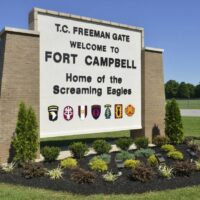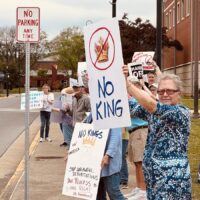Sherman Neal spent many days of the summer of 2020 in the Western Kentucky college town of Murray next to a Confederate monument at the county courthouse.
It was on the heels of the murder of George Floyd and the fatal police shooting of Breonna Taylor when Neal — a Black volunteer college football coach, veteran and recent transplant to the city — penned an open letter to local leadership calling for the monument to be removed.

In that letter, he evoked his young children, saying if they asked about the monument, he would have to tell them it was a racist symbol put in place “to keep Black people quiet and subservient.” The monument, which features a statue of Confederate general Robert E. Lee, was erected with funds from a local United Daughters of the Confederacy chapter in 1917.
Neal’s letter sparked a movement that led to months of protests, a local man assaulting protesters with mace and a march on the county courthouse square, a place where those wanting the monument to stay often confronted those who wanted it removed.
“You don’t get too many opportunities in life to go through real shared hardships together and learn lessons at the same time,” Neal said in a recent interview with the Lantern. “It takes actual experience sometimes to learn certain things and build certain bonds.”
A new documentary, “Ghosts of a Lost Cause,” captures the struggles and bonds built by those in Murray who pushed for the monument to be removed.
It is one of a series of documentaries airing this Saturday in communities across Kentucky, coinciding with a regional tradition of celebrating emancipation from chattel slavery on Aug. 8.
The Rural-Urban Solidarity Project, coordinated by the organization Kentucky Rural-Urban Exchange, is airing four films that chronicle actions and protests for racial justice that Kentuckians took following the killing of Breonna Taylor, while also uplifting and celebrating Black communities across the state.
Robyn Pizzo, a resident featured in the Murray documentary, made “Move the Monument” yard signs that sprouted across the community. She said watching the film is “painful” and “heartbreaking” in some ways given that advocates, like herself, for removing the Confederate monument didn’t achieve their goal.
Lee’s statue remains by the county courthouse after the Calloway County Fiscal Court decided to keep it on county property in 2020. But the bonds made between Pizzo, Sherman and other community members throughout those efforts also remain.
“I think some of the power in the storytelling is the diversity of the people who were interviewed and the people who were part of the movement, like the backgrounds that we all came from, our motivations to join, how it’s impacted our lives since,” Pizzo said. “I think that there is a hope, that even individual people making small changes can have an impact to the future of what Kentucky looks like and making it a more welcoming and equitable place for everyone.”
Years in the making
Savannah Barrett, the co-founder of the Kentucky Rural-Urban Exchange, is still deeply connected to her roots in Grayson County.
Barrett helps lead the Exchange, an organization that brings together Kentuckians from rural and urban communities to share ideas and create understanding and bridge divides.
When people began to fill the streets of her current home in Louisville following the police killing of Breonna Taylor, she was also hearing from people she knew about Black Lives Matter protests popping up in smaller communities across the state, including in her home of Grayson County.
She saw that younger people in Leitchfield, the Grayson County seat, were organizing a protest at a local courthouse.
“I can say without a shadow of a doubt that that has never happened in Leitchfield,” Barrett said.
She said she recognized the protests sweeping across rural communities in solidarity with Black Kentuckians was something “very special,” and working with filmmakers she knew, efforts began to capture some of those moments on film. The ideas for the documentaries were conceived from that footage.
“We started to work with our member network to try and figure out how to make these films in a way that was by and for the folks who were supporting these actions across the state,” Barrett said. “We needed to hear from more Black Kentuckians. We needed the leadership and oversight of some of the luminaries in African American arts and culture in the state.”
As the ideas for the films progressed, she reached out to people such as Betty Dobson who runs the Hotel Metropolitan, a storied hotel-turned-museum in Paducah that hosted Black travelers including stars such as James Brown and Louis Armstrong during the era of segregation. A documentary highlighting Hotel Metropolitan’s history and the importance of preserving and sharing Black history, “Preserving the Past to Build a Better Future,” became one of the films in the series.
Barrett said the films are purposefully being shown around when gatherings take place for Black communities in Kentucky, specifically the Old Timers festival in Covington and the Eighth of August emancipation celebrations in Western Kentucky. The film in Harlan County is also dedicated in the memory of two people featured in the documentary who have since passed away.
“It just felt right,” Barrett said.
Other documentaries that came into shape include “Words I Speak: Solidarity + Resiliency,” featuring stories of Black women leaders from Northern Kentucky who stepped up to organize their community or run for office.
Another film being showcased in Harlan County highlights the Eastern Kentucky Social Club, a treasured gathering space and far-flung network of friends and family. The film also details the challenges and resilience of Black people in the mountain county.
“We looked at different stories,” said Gerry James, one of the filmmakers involved with the documentaries. “We wanted to have diverse geography.”
James was particularly involved with the production of the film in Murray. The story of Sherman Neal and his struggles to remove the monument personally resonated with James, who is also Black. James works in outdoor recreation planning and recounted a story of visiting downtown Glasgow in southern Kentucky to help build a trail.
“I pulled up to downtown Glasgow, and I parked right in front of a Confederate monument. And then a Black family walks past,” James said. “It just reminded me of myself in that moment and how I felt about that monument.”
James said he wanted to show the “humanity” of those involved to remove the monument in Murray, noting Neal’s background as a Marine veteran in challenging a monument dedicated to Confederate veterans.
Neal faced a backlash for being a frontline advocate for removing the Murray monument. He left Murray in 2021 after he wasn’t brought back on his college football team as a volunteer coach.
But he feels it’s still important to document movements, including ones that don’t achieve every tangible goal, for future posterity.
“A lot of times we look at the ‘I Have a Dream’ speech,” he said. “‘Oh, that’s great.’ Well, there’s a lot of bad that comes, too, and sacrifice that comes with all these things. And I think it’s important to capture the reality of some of that.”
How to see the films
The documentary showings are taking place Saturday, Aug. 5, at three locations across the state:
“Words I Speak: Solidarity + Resiliency” at 1 p.m. EST at the Kenton County Public Library, Covington branch. Event Link: https://tinyurl.com/SolidarityNKY
“Harlan – Film Synopsis” at 6 p.m. EST at the Southeast Kentucky Community and Technical College, Cumberland. Event Link: https://tinyurl.com/SolidarityEKY
“Ghosts of a Lost Cause” and “Preserving the Past to Build a Better Future” at 5 p.m. CST at Maiden Alley Cinema, Paducah. Event Link: https://tinyurl.com/SolidarityWKY
A virtual showing of the documentaries will also take place Tuesday, Aug. 8, at 12 p.m. EST. Find the Zoom video conference for the event here.
Liam Niemeyer covers government and policy in Kentucky and its impacts throughout the Commonwealth for the Kentucky Lantern. He most recently spent four years reporting award-winning stories for WKMS Public Radio in Murray.





